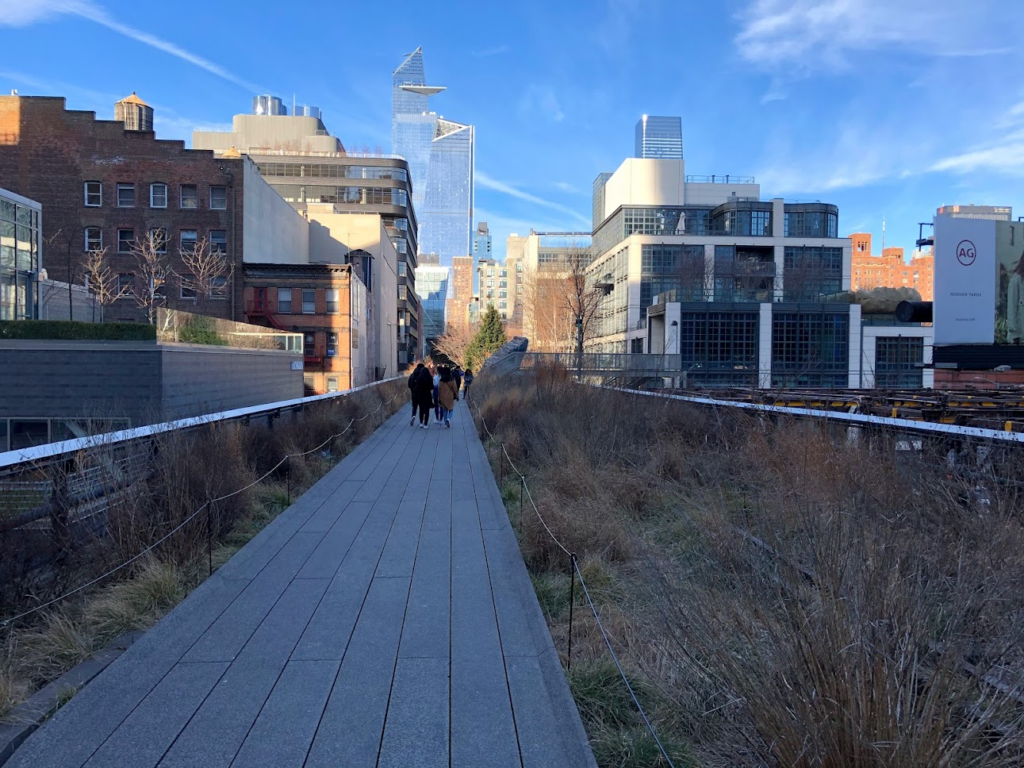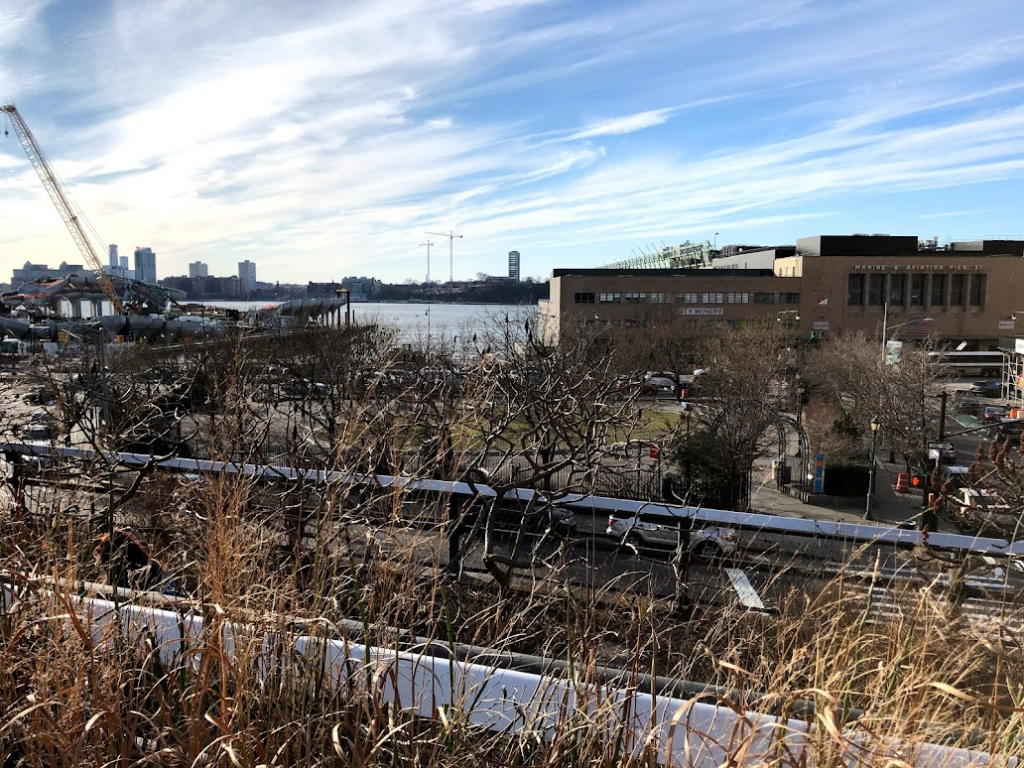The High Line, NYC
In my previous post, I wrote about the need society has for imagination and inspiration.
This is another story that brings this to life. It’s a great example of why starting with an idea matters – the ability people find to hold a vision of what could be possible, before finding a way to make that idea a reality.
If you’re unfamiliar with the High Line in New York City, it’s an urban transformation project that has repurposed an abandoned elevated railway into a public park.
The one thing I would say upfront is that you won’t fully appreciate the High Line until you visit it. Back in February 2020, just before the pandemic shut the world down, we took a family trip to New York. This was a joint 40th birthday celebration with the High Line a must visit on our itinerary.

As it turned out, we visited on a cold but sunny New York day, complete with blue skies. After grabbing coffee to go, we took our time walking most of the route to Hudson Yards. I was impressed at the time, and, over 5 years later, I still think about this as a great family experience.
What starts with vision…
Not only should you visit the High Line if you’re ever in New York, but the story of how this idea became reality is worth understanding from a number of perspectives.
I’ve taken most of the following insight from the book: The High Line: The Inside Story of New York City’s Park in the Sky. The book is written by Joshua David and Robert Hammond. They were two New Yorkers with no prior experience in planning and development who managed to make the High Line a reality through the group they cofounded: Friends of the High Line.
The High Line was originally built in the 1930s as an elevated freight line, designed to transport goods from places like the meat factories directly to Manhattan, avoiding street-level traffic. By the 1980s, the use of trucks and New York’s highways had made it obsolete. And by the 1990s its abandoned structure was overgrown – property developers pushed to demolish it to free up land for lucrative real estate development.
Josh and Robert became part of the story in 1999 with a shared idea of transforming the former railway into a public green space. This not only took them several years to achieve – another 7 years before development work on the site even started – they had to collaborate successfully with the community and local businesses, elected officials, and forward-thinkers from both horticulture and landscape architecture.
1. The importance of an idea
What I find most interesting about this story is it started with a very simple vision for what the High Line could become.
Both Josh and Robert were interested in the High Line because it was part of their neighbourhood. They both saw its potential. They were also curious about its history and cared about how its future would impact where they lived.
As an example, it was enough that the High Line started with a simple idea. There was inspiration needed here as well …As Robert explained: “I liked the idea that trains used to run through my neighbourhood.”
2. Timing and luck
The starting point of their story was Josh and Robert meeting at a community board meeting in the summer of 1999. This was after they had both separately heard about plans to demolish the High Line.
The meeting was intended to present different potential uses of the High Line as part of a commissioned study, but it was dominated by developers and others arguing for its demolition. At this time, Mayor Giuliani’s administration also wanted the High Line to be pulled down.
At the meeting, Josh, who was a freelance writer, had sat next to Robert whose background was in consulting and business. Robert later stayed behind at the end of the meeting to find anyone else interested in saving the High Line. They ended up speaking for the first time. A chance encounter.
Josh and Robert later described how they relied on the skills of others, but also luck and good timing in how the High Line progressed. This included harnessing the enthusiasm of later Mayor Michael Bloomberg, and how they were able to benefit from concerns about urban planning issues following 9/11.
This is an example of how luck and timing does matter. But also the ability to connect with and inspire the right people, making full use of any opportunities to make progress.
3. The importance of design
Josh and Robert talk about using design throughout the project, including in a way that “united a lot of our early supporters.” They describe the importance of design in a bigger sense – thoughtful design, and thoughtful planning.
A good example of this can be seen in the eventual architectural approach of the project. As explained by Ric Scofido: “My job as an architect [was] to save the High Line from architecture.” Thousands of architects had looked at the High Line as an opportunity to build things. However, Ric’s team “focused on stripping things away and exposing the underlying structure instead of adding to it.”
When I visited, I noticed how the High Line’s landscaping carefully incorporated systems of railway tracks, sleepers and vertical lines, true to its history while guiding you along its new walkways and green spaces.
4. Innovation from constraints
Many of the design innovations you can see today on the High Line come from working within constraints. There’s a good example of the need to adapt designs around an 8ft rule for fences where bridges on the High Line ran across main roads like Tenth Avenue. These fences could have been a big negative on the project, but through carefully assessing options and looking at other examples in the city – like the Brooklyn Bridge – they were able to design alternatives that ensured safety without blocking views. From my 2020 visit, I can remember some of these designs, including carefully positioned windows looking out at key crossing points.
Another aspect of the High Line I like is that this is a type of innovation that comes through an act of preservation. For Friends of the High Line: being able to see the true value and potential of what was already there.
5. Making things open, and show don’t tell
The book describes how Open House New York events were used to great effect in the early stages of the High Line project, where people would queue to visit the derelict site on open days:
“[Visiting the High Line] was really important to public support, people needed to see it, they were curious.”
Josh and Robert needed people to experience the High Line first-hand, to see its potential and experience its magic. This included officials who needed to understand the idea. They were often taken up onto the High Line to see it for themselves – with stories that included officials having to squeeze through gaps in fences to get access to the site.
Early in the book, there is also an example of how professional high-quality photography was first commissioned – working with the photographer Joel Sternfeld – to show the beauty and potential of the High Line. These images were used successfully in brochures as well as in high-profile newspaper articles.
6. Meaningful community participation
A key part of The High Line becoming a reality was gaining the support of the local community. A great example of this was the High Line Portrait Project.
Local people were invited to come have their photo taken with a High Line backdrop, eat pizza, and talk about the High Line. Guests posed in front of a large print of one of Joel Sternfeld’s photos, which: “when you stood in front of it […] really looked like you were on the High Line.” They then printed these pictures so people could take them home with them.
They also thought about how to involve people in the project in several other ways. As described:
“Because the High Line was a dream coming true, we also asked [the community] to write down their dreams. We made posters with montages of the photos and put them up on construction fencing near the High Line. We also put them online, with each person’s dream listed beneath their photo. People loved it. They could visualise themselves up on the High Line and started asking when it was going to open, what were the access points, what kind of things would go up there.”
This is a great example of meaningful community engagement building both excitement and anticipation in new ideas and experiences.
The result
With the first phase of the High Line opened to the public in 2009, it is now described as:
“A mile-long expanse of plants, paths, staircases, and framed vista–runs through a transformed West Side and reminds us that extraordinary things are possible when creative people work together for the common good.”
The High Line has rapidly become one of New York’s most popular tourist attractions. Additional phases opened over several years, with the final section completed in 2019. This extended the High Line to where my family completed our walk in Hudson Yards just a year later.

As well as understanding the practical lessons of how this project became a reality, the world definitely needs more imagination and inspiration like this.
This is my blog where I’ve been writing for 20 years. You can follow all of my posts by subscribing to this RSS feed. You can also find me on Bluesky and LinkedIn.